
ONTARIO

Boblo Island
NO PART OF THE FOLLOWING
ARTICLE AND PHOTOGRAPHS
MAY BE REPRODUCED WITHOUT
PERMISSION FROM THE AUTHOR ©
The French originally called the island from which the park takes its name "Bois Blanc" (BWAH-blonk - White Woods) because of the many birch, beech, or white-barked poplar trees that dotted the area. (Different sources cite different tree types, so all are mentioned here until conclusive evidence points to one in particular.) As time passed and English settlers became more numerous, the name was eventually unintentionally modified to "Bob-Lo" by persons that mispronounced the French name. In the 1980s that name came to be converted to the present spelling of "Boblo". (There still is a Bois Blanc Island, but it's a different one located in Lake Huron many hundreds of kilometres away from this one. It is part of the State of Michigan.)
The island, which was approximately 5 X 1/2 kilometres, became partially developed in the 1870s & 80s with some stables to support horse riding, some picnic areas, and some streets and roads. However these were for private functions put on by the Island's owner McKee Rankin, whom had bought the island from his father in 1869. By 1886, his wife divided the island up into lots. (Presumably, McKee had died.) Ads proclaimed 317 lots were for sale at $250 each, including the one with the McKee house and stables.
The island changed hands a few times after that, but it took the purchase of a small area by The Detroit, Belle Island, and Windsor Ferry Company in 1897 as an investment and as a way to boost patronage during off times to really kick things off. In 1898, this would become The Bois Blanc Excursion Line. For the opening and within the first years of the park, they erected an athletic field, baseball diamonds, bathing facilities, a 500-metre cinder bicycle track, a boat livery with a 75-boat capacity, an observatory, tennis courts, a bath house, cottages, and other facilities to draw the crowds.
The grounds were cleared. Grass and many flowers, trees and shrubs were then planted. However, no lighting was incorporated as they did not wish the park to become a haven for "midnight owls". Lighting would later be utilized, though, and one of the first uses would be on the park's carousel.
Using the ferry "Promise" (1892), on June 18th(?), 1898 the park was opened to the public. It was so well received that the company began to purchase more of the island and install additional facilities which attracted more business so that they eventually saw enough profits to purchase all but a small portion of the rest of the island. (The park would boast a 110-hectare site by the time of its closing.)
The park's opening date is in contention. The Detroit Evening News from the period shows different dates. Long time Detroit-area resident & amusement park researcher Mike Schulte says "I've seen two dates attributed to the public opening of Bois Blanc Park: June 11 and June 18 1898."
Mike continues: "According to the very first advertisement I spotted on page 2 of the June 9, 1898 Detroit Evening News, the first excursion aboard The `Promise' to Bois Blanc Park was scheduled for 9 AM Saturday, June 11, 1898 with a second departure at 3:30 PM. Daily service at those times was to begin on June 18th." However, the newspaper stories concentrated on a June 20th date because they had an effective park buy-out for the newsboys' picnic. The `Promise' was packed that day with newsboys, while the "Sappho" carried their families to the island for a day of ball games, races and other activities."
It is possible that the June 11th excursions were called off, but Mike didn't spot any news to that effect. He feels the June 11th date was a "soft opening" as it was advertised as a "Special Excursion". Regular service seems to have started June 18 with an official dedication on Monday the 20th during the outing held for boys selling newspapers in the area. Newspaper articles also give the 18th as the "formal" opening.
Ferry rates from Detroit were 35 cents for a round trip leaving at 9 AM while afternoon (3:30 PM) rates dropped to 25 cents. The on-board entertainment was Schremser's 4th Regiment Band Orchestra. Return trips were a 2 and 8 PM.
For the July holidays, special events were planned. There is nothing yet found for Dominion Day (now Canada Day), but The American Independence celebration of July 4th had Zickel's Orchestra for music & dancing, plus boating, bicycle races, baseball, croquet and tennis. Zickel's also apparently played on board the ferry "Promise" and ads through at least 1908 show the band remained popular and still continued to do the Bob-Lo "gig". The band increased in size by 1903 because ads from that year on show it as "16 pieces".
A 1901 park ad mentions the opening of the new "Bois Blanc Cafe" and the use of the ferries "Promise" and "Pleasure". For July 4th, both boats offered on-board music and at least one offered a live band on other days, as well. July 4th was sold out with 2,580 tickets purchased. It was estimated that another 400 could have been sold. July celebrations continued to do well for over a decade and a half despite a limited turnout in 1905 due to poor weather.
An incident in 1902 caused a man-made mini earthquake on the island. A shack which held dynamite used for dredging the near-by channel was fired into by a group of boys out hunting or fishing. It blew up, shaking the island and sending rocks flying. No one was injured, and there is no word as to what punishment the boys received.
In the first decade of the new century, good profits would see the ferry company buy three new 2500-passenger ferries: The "Columbia" (1902), "Britannia" (1906), and The "Ste. Claire" (1910). All had dance floors and beer gardens on separate decks. The "Columbia" and The "Ste. Claire" would provide service to the island park until the 1991 season.
By 1906, the ferry companies and resort destinations had product tie-ins just as we have today. Instead of soft-drink and drug store coupons, they had soap companies like Detroit's "Queen Anne Soap" which gave premiums for each wrapper turned in. These could be used to get excursion tickets for places like Bois Blanc. Bessie Booth Lodge is advertised as the performer on board The "Columbia".
A new electric plant was advertised for this year, so this may have been the first season the park was lit, and may also be a clue as to the fact the park may have had a carousel by then. As mentioned earlier, one of the first things illuminated in the park was a carousel. Chicago researcher, Jim Abbate, says the park got a Mangels-Illions ride in 1905, with 1906 being its first season. A 1980 Boblo Island Park brochure mentions this ride was illuminated early in the 20th century. The carousel had 44 horses, 2 goats, and 2 deer. Also included was a band organ for music.
|
Spectators watch in this early shot of
the park's carousel. It appears to be
enclosed.
|
Carousel
19-0s or Early 1910s 
|
The Methodist picnic was a big event that season with 6,000 attending, despite cool, rainy weather. Several days later, the Masonic picnic occurred. It featured foot races with prizes, and dancing. An interesting event was the "Stammerers" picnic which attracted 100 persons with speech difficulties. It was put on by the Lewis School which worked with speech-problem sufferers.
By 1907, expected crowds for the American July 4th holiday via The "Columbia" and "Britannia" ferries from Detroit were 10,000. This would not count Canadian patrons whom got to the park via other means. Moonlight cruises via The "Columbia" were advertised for every Tuesday and Friday evenings leaving Detroit at 8:30 PM. A Sunday lake cruise which ran from 8:30 - 11 PM, was available for 25 cents.
1908 Fourth of July crowds were estimated at 20,000 from The United States alone. The park had a record year.
Advertisements of 1909 showed "Columbia" moonlight cruises every Tuesday and Friday, with a special one on Sunday, July 4th for both The "Columbia" and "Britannia". Liquor was still not sold or permitted. Business boomed with a reported 10,000-plus at Bob-Lo on June 26th. On-board entertainment for The "Columbia" on the 4th was a full orchestra with solos by Charles Clohecy. His name would appear in a later 1915 and 1916 ads, so he apparently remained popular with holidayers. Queen Anne Soap still sponsored excursions to the park. Regular park and moonlight rates and were 35 cents for adults, 25 cents for children. A buffet lunch was advertised for daytime crossings. Business was brisk that season.
That season was also the first indication that the island park had become known and accepted as "Bob-Lo". Advertisements showed the name for the first time although the island name still was shown as "Bois Blanc". From this time on, the "Bob-Lo" name would grow in size in the ads with "Bois Blanc" growing smaller and in parentheses, and disappearing altogether in some ads by about 1915. Eventually the island itself would take on this spelling and the hyphen would disappear in the 1970s or 80s.
1911 ads show the "Ste. Claire" for the first time. Rates are still 35/25 cents. Moonlight cruises are now held on Tuesday, Wednesday, Friday and Saturday of each week. For 1912, the moonlight excursions were extended to run from Tuesday through Saturday and divided between The "Columbia" and "Ste. Claire". An additional 1:30 PM trip was added to the day schedule for Sunday, Wednesday, Thursday and Saturday.
The owners used their profits to replace the Albert Kahn-designed dance hall, which had been bankrolled and built by Henry Ford in an earlier expansion, with a huge new one. Started near the end of the 1912 season, it was completed by the park's opening day of 1913. The massive 3300 square-metre hall was constructed of steel & stone. One side of the building featured a tall cathedral-like glass wall. It was bordered by two rectangular stone-faced pillars with windows and flag poles. This building housed the largest dance floor in North America until The Crystal Ballroom opened at Crystal Beach.
|
Pavilion Dance Hall (Date Unknown) 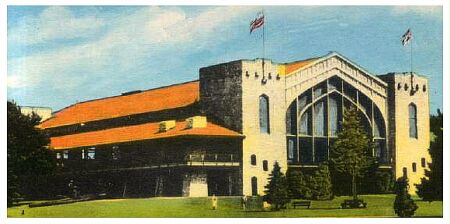
|
| The cathedral-style of the pavilion is evident in this photo. |
Overlooking the large floor was a viewing gallery to which there was no admission. The dancers below were charged 5 cents a couple. The ferry company, in the interest of family entertainment, did not allow "wild" dancing at the pavilion and outlawed the turkey trot, bunny hug, and bear dances. Later, this was eased, and by the 1940s there would even be special nights held for jitterbugging.
|
Pavilion Dance Hall Likely Late 1940s or Early 1950s 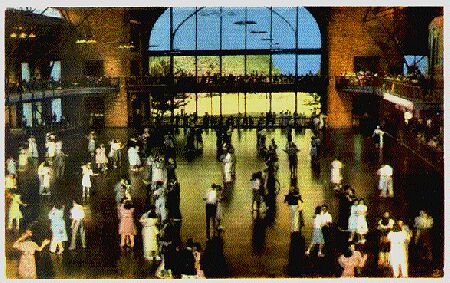
|
| The dance floor just inside the cathedral windows is shown here. Notice the balconies where those not dancing could observe the activity below. |
1913 ads show a price increase for the holiday Moonlight Cruise to 50 cents.
Mainland businesses took advantage of the crowds heading to the various resorts. A 1916 notice shows The Lakeview Hotel targeted Bob-Lo patrons with an ad for a 50-cent fish dinner for the July 1st holiday.
The island resort continued to prosper through The Great War and afterwards. Many churches and organizations held their annual picnics there. Some in particular were the Recorder's Court Clerks, which held its annual events there for most of the decade, The Detroit Traffic Club, and The Mack Avenue Business Men's Club. A 1918 ad mentions The "Columbia" and Ste. Claire" ferries with weekday Detroit departures at 9 AM and 1:30 & 3:00 PM. Rates were 40 cents and 25 cents for children. Those travelling from Bob-Lo to Amherstburg in Ontario required Draft Permits, if of draftable age. Moonlight Cruises were every night except Sunday and Monday for 45 cents. All rates were higher on holidays.
By 1923, the ferry sailing frequency was still the same but the moonlight cruises were 60 cents and the holiday moonlight trip was up to 75 cents. The "Columbia" advertised an evening cruise with a full orchestra and soloist Thomas Lahey, but stated "no dancing". Perhaps the music featured was more of the listening type. Later ads confirm this with the word "concert", and also mention another soloist, Gladys Howenstein. This entertainment was continued on Sunday nights at least into 1924. Price was 60 cents. Regular fares were 30/25 cents, except Sundays when adults paid 60 cents.
1924 ads also mention the dance hall and fish, steak, and chicken dinners at the cafe. Two additional ferry sailings are placed on the schedule and regular fares seem to be 60 cents for everyone.
The island resort continued to prosper through the 1920s with dance, baby, shampoo & other contests, weddings, company picnics, and sports competitions bolstering business. A very brief article in the June 12, 1925 "Detroit News", stated that for the first time a telephone cable had been run to the Island and four telephones had been installed connecting the Island to Amherstburg. Ads that year proclaimed the latest attraction was a new cafeteria, located just left of the ferry pier at the park. It had large polished-wood posts supporting a high ceiling, with all windows gracing one side. Patrons served themselves and dined at four- seat tables. One food advertised was Lake Huron Whitefish or Trout. The cafeteria was supposedly operated at cost by the ferry company for those whom "cannot, or do not wish to carry their own lunch", as one ad proclaimed.
Also, a special Memorial Day (a late-May holiday in The U.S. once known as "Dedication Day") excursion would occur that season with ferries from the Detroit/Windsor, Ashley/Dustin and White Star lines providing transport. The regular season was to open June 1st. Entertainment was to be Lorenzen's Famous Imperial Orchestra. This is the first year ads were placed this early, so it may mean the Bob-Lo season was now starting earlier than it previously had.
Unfortunately, it would not be a boon to Canadians. That year, Ottawa imposed a customs inspection on the Amherstburg run of the Detroit/Windsor ferry "Pappoose". The ferry company cancelled the run, meaning Canadians would have to boat over on their own or drive to Detroit to take one of the ferries from the American side. Regular fares increased to 75 cents, but Moonlight fares remained at 60 cents. A park slogan of the time was "Where Fun Begins" and ads depict a slide, teeter-totter, and a beach.
An unfortunate accident saw the loss of assistant concession stand manager on board The "Columbia". The 18-year old Alphonus Krebsback was recovered on July 15th after his rowboat tipped over while riding the waves from the wakes of the big steamers the previous Sunday (July 10). Two others in the boat survived.
No information has surfaced for 1926, but the park opened on May 30th for the 1927 season and The Shriners of Moslem Temple held their spring ceremonial there on June 2nd. 6,000 members, which included a 60-piece Shrine Orchestra and The Arab Patrol, attended. Ontario, Michigan, Ohio, Illinois and Pennsylvania were represented within the attending group.
Golf is mentioned for the first time, so it's assumed that a golf course was constructed in 1926 or 27. The band for the Moonlight cruises was Jean Goldkette's Orange Blossom Orchestra. As well, a Mangels "Whip" is also mentioned. It was run that year by Western University senior class man Arthur Hoppins and basketball player James Howell. Information on the park's rides in the first half of the 20th century is scant. It's likely that there were at least the carousel and "Whip" at this time.
An article of note is that in the 1920s and 1930s long-distance swimming records were being broken on a regular basis. That year, five contestants swam from Belle Isle Bridge to Bob-Lo Island, a distance of 38 kilometres. Two dropped out, leaving 17-year old Dorothy de Caussin and 15-year old Ida Mutnick to complete the swim in 8 hours, 42 minutes. They broke the old 1911 record of 11 hours, 26 minutes, as did a third contestant, Jack Hans. He finished in 9 hours, 22 minutes. All finalists were residents of Detroit.
These types of contests escalated and reached their peak with the crossing of Lake Ontario in 1954 by Torontonian, Marilyn Bell. She swam 51 kilometres from New York State to The Boulevard Club at Sunnyside Amusement Park in 20 hours, 57 minutes. Her landing site is now called "Marilyn Bell Park", named in her honour.
That year (1927) The United Commercial Travelers held their first ever picnic at Bob-Lo. It attracted 5,000. Other picnics mentioned for that season were The United States Naturalization Bureau, The Police Lieutenants (August 8th), and The Scotch Picnic and St. Andrew's Society Picnic, both held August 18th. The Scotch Picnic drew 12.000. Events included a parade with participants in traditional costume, bagpipe contests, and sport games like the caber toss.
1928 opened with The Orange Blossom Orchestra still featured. The Shriners picnic (attracting 7.000 was held on June 2nd), and The University of Detroit outing (June 6th), featured a Best Looking Girl & Senior Man competition, dancing, swimming, tennis and golfing. The International Advertising Association's convention in July also included an excursion to Bob-Lo.
Despite the loss of the Canadian ferry run in 1926, Bob-Lo Island continued to prosper in the mid to late 1920s partly because some of its American competitors closed, leaving more customers for Bob-Lo. Starting in the 1920s, nearby Detroit began to force some of its urban amusement parks to close because many thought of them as dirty and as places for gambling and other unsavoury activities. Mike Shulte speculates that by the 1930s even some of the excursion parks may have suffered from public pressure, and that coupled with The Depression found less & less customers coming to them. This was aggravated by the fact that many more people owned cars. Instead of taking a longer boat ride, these people would use the new roadways & tunnels that bridged Canada and The United States to bring them to ferries nearer the park. These included the Ambassador and Blue Water bridges, the Detroit-Windsor auto tunnel and the railroad tunnels under the Detroit and St. Clair Rivers. This allowed for more time at the park but hurt ferry business.
Nothing has surfaced for the years 1928 through 1933. This is logical for 1930 onwards because of the Stock Market Crash and ensuing economic depression. However, one would think that ads for 1929 would have appeared because the market did not crash until October 29th.
The Depression, auto transport, and a general decline in park patrons caused the Bob-Lo ferry company to get into financial trouble. They had to close the park for the 1933 and 34 seasons due to loss of business and stoppage of ferry service. A new ferry company decided to enhance the area with a full-fledged amusement park. So in 1935 the island re-opened. Ads proclaimed a special 55-cent dinner and advertised Rex Battle's 12-Piece Dance Orchestra. Things went well enough for the new company to expand with new docking facilities for private boats along with other improvements. However, as the lean 30s progressed, despite the closure of competitor Sugar Island in 1936, the company eventually was forced in 1938 to sell out to new owners (Bob-Lo Steamship Lines?), who also had a bit of a hard time initially. However, they did manage to convert two ferries from coal to oil burners and improve the docking facilities.
Little is known about the next few years and into World War II, which began in September of 1939. Attendance fell for a few years after the start of the war from Canadians who after June 1940 were required to have a passport to go to the park even though it was on a Canadian Island. This was because the ferry would pass through American waters. The Americans, who had not yet entered the war, wished to police people entering The United States via Canada who might travel to the island using a Canadian ferry and then depart on an American ferry to enter illegally into The U.S. In order to visit the island, those departing from Ontario would now have to travel to Detroit and board a ferry there. Canadians were not impressed.
The next season the island also earned a bad reputation on the other side of the border from an incident that temporarily left a number of Michigan children, estimated to be as high as 10,000, stranded at the park after a school outing. They had arrived separately throughout the day of June 9th, 1941 but all stayed till park closing, and thus had to leave at the same time. The ferries couldn't handle the crowds. The last boat didn't arrive in Detroit until 3 AM which prompted anger from many parents who waited & worried on the Detroit dock all evening and into the next morning. This time, it was Americans who weren't impressed.
Other incidents during the 1940s that marred the reputation of Bob-Lo were a drowning and a labour dispute by park employees. This dispute, which led to a strike, was triggered by consistent delays in receiving paycheques, but was resolved when the cheques arrived. About a week afterwards on Dominion Day (now Canada day) July 1, 1942, a 14-year old girl fell from a ferry boarding walkway and drowned before she could be rescued. Despite these episodes, attendance was enough to continue operations and it actually increased by the mid 40s with the bad incidents behind it.
Unfortunately, increased attendance attracted thieves looking for the increased revenues. In 1945, they stole $10,000 and on July 8, 1946 robbers struck again. A group of four first sank all the small boats on the island save for one rowboat which, they eventually used for their escape. The telephone lines were cut and four park employees were restrained while the park's safe was blown open. They netted Saturday and Sunday's receipts of approximately $12,000.
The park moved on. 1945 advertisements showed 5 ferry crossings daily with rates at 85 cents (adult) and 35 cents (children). Sunday & holiday rates were $1.00/50 cents. Also advertised is the new cafeteria. it's not clear if this was a refurbishment of the old one or an entirely new building.
That year, an incident with a Detroit street gang would be a harbinger of events which would contribute to the closing of the park. Six gang members aged 16 - 19 were arrested after an argument on board the Bob-Lo ferry erupted in violence towards a park waiter. After the July 1st celebration, they remained at the Detroit dock until the waiter departed at 12:45 AM the next morning. Twelve officers (municipal and military) broke up the fight which had a total of 14 gang members involved.
Shortly after war's end the park had along with its picnic facilities and dance pavilion/ballroom, 6 adult rides, 4 refreshment outlets, a skating rink, a miniature train, and kiddie rides. The skating rink may not have been a separate building because the image below shows people roller skating in the dance pavilion. However, decades later, The "Carrousel Theatre" was supposedly converted from an old roller skating rink. This implies that the rink and pavilion skating were separate. Perhaps at some point skating became so popular that a spearate rink was constructed.
|
Pavilion Dance Hall 1940s ? 
|
| Seen here are roller skaters in the pavilion. |
One of the 6 adult rides may have been a Traver "Tumble Bug" which was in the park in at least the late 1940s according to Lorenzo "Red" Browning, whose family would purchase the park in 1948. (One source gives 1949, which might simply have been the first season they ran the park, given that they acquired it late in '48.)
Another ride was likely the 1878 48-animal Mangels-Illions carousel. As already mentioned. Jim Abbate says the park got the ride in 1905 and it was put into operation for the 1906 season.
A few seasons after the war, passport requirements for Canadians were dropped with the re-commencement of a ferry from the Canadian shore. 1949 saw new owners (The Browning Family) operating under the name of The "Bob-Lo Company", willing to improve the island even further. The ferry company was called The "Browning Line". In 10 years, the rides compliment would rise to 27, including a new miniature train, a funhouse, an antique car display, and some rides imported from Europe. Ringling Brothers performer Joe Short, was hired to perform as a clown on the ferries. He used the moniker "Captain Bob-Lo" and worked the boats until 1974 at age 99!.
One thing that helped Bob-Lo in the first two decades of Browning ownership was the closure of more rival parks. Mike Schulte says: "By the 1940s, the second-generation of area amusement parks were in trouble and facing NIMBY (Not In My Backyard) pressures. Eastwood was the first to close around 1949. By this time, the automobile made it relatively easy for most to get away from the city whenever and wherever they wanted to go. It was in this environment that the Brownings bought the Island. While the aging amusement parks were failing, the Brownings likely saw the opportunity to breathe new life into Bob-Lo by creating a new, third generation amusement park."
"1951 would be the end of Tashmoo Park. Jefferson Beach would close in 1959. Farther inland, Walled Lake Park was gone after 1968. Bob-Lo's last major competitor in Detroit, Edgewater Park, would throw in the towel in 1981."
However, this was all to come. In 1949, the park opened for the May 28 - 30 weekend with seven daily sailings. Rates were $1.30/65 cents. Ads proclaimed the "2nd largest dance hall in the world". Presumably, Crystal Beach's "Crystal Ballroom" was the largest.
Some rides in the 1950s were, or would come to include, a full-size "Whip" (Mangels), a "Moon Rocket" (Herschell) and a "Hook-N-Ladder" Fire Engine ride. This was a little larger than an automobile so both children and adults could ride. The "Whip" must have been a replacement unit for the previous one.
This was the first season for the "Shakedown Cruise" which honoured Mexico. It continued at least into the mid 1950s. For the 1956 season, it would be touted as honouring three nations with an American ship sailing to a Canadian island for a Mexican party.
By 1954, the Moonlight Cruises were still happening with entertainment such as dance lessons & exhibitions by the Robert Morgan Dancers, various games with prizes, and Polka Night, featuring Johnny Sadrack's orchestra. They were popular enough that for the 1955 July holidays, there were two Moonlight Cruises each night. The Scottish and St. Andrew's picnics were still at Bob-Lo and amusement rides are now mentioned in the ads. As an incentive, children were not charged on the Bob-Lo ferry on Mondays.
The 1956 season opened May 30th and ferry prices were back down to $1.00/50 cents. Sundays, holidays and Moonlight Cruises were $1.50/65 cents. (The moonlights excluded children.) Island admission was now 10 cents.
For the 1957 season, the lake and river channels were being widened in conjunction with The St. Lawrence Seaway project. Although not part of that project, a general upgrading of facilities was occurring in anticipation of the large ocean-going vessels that would be able to reach the Windsor/Detroit area. The start of one such event was accompanied by celebrations near Bob-Lo on May 28th with a ships parade and tugboat races.
New that year were The "Wilde Maus" and The "Super-Satellite Jet" (both Klaus). Mike Shulte has located ads for The "Wilde Maus" in The "Detroit Free Press" and The "Detroit News" on July 25, 1957. They both read as follows:
* SENSATIONAL NEW RIDES FROM GERMANY AT BOB-LO *
`SUPER-SATELLITE JET' AND `WILDE MAUS'
There are no thrills like these new rides especially
made in Germany. There's nothing like them in all the
Americas. Steer yourself through the `wild blue yonder'
on The `Super-Satellite Jet' or dare the hairpin turns
of The `Wilde Maus'. To enjoy these new wonders -- and
all the other attractions of Bob-Lo -- take any of the
convenient sailings."
The ad copy concludes with list of times, specials and contact info. (See farther on for a discussion of the "Maus" ride.) Both rides attracted a number of amusement park and carnival owners, likely brought in by Conklin Shows as a mini trade fair.
In addition, Mike noticed the "Detroit Free Press" on July 28th ran a poor-quality photo of the "Super-Satellite Jet" being enjoyed by park visitors. In the background is what looks like a Hrubetz "Round-Up", likely acquired sometime during this decade.
It was reported that the 1957 season was slightly better dollar wise, despite a drop in attendance due in part to poor weather. The biggest day was August 15th for the annual St. Andrews Day picnic when 9.000 attended.
For 1958, Bob-Lo also added new trains to the ride that circled the park. A November 1957 "Billboard" article said two trains were ordered from National Amusement Device (NAD) as part of Bob-Lo's major ride expansion program. They would last at least until the mid 1970s when they were replaced, or at least added to, with Chance C.P. Huntington units. Also mentioned in the article is that the park had a "trackless" train. This sounds like a rubber-tired tram. No other mention of this ride has surfaced, though.
| Here is one of the trains used by the park. It's unclear if this is one of the NAD trains or if this was the previous one. In the background is one of the Bob-Lo ferries at the dock. |
Bob-Lo Train and Ferry 1960s ? 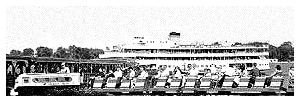
|
Also added in 1958 was a "Sun Valley Cortina Bob". A Wedemeyer "Billboard" ad describes it as "A Slanting Circular Ride, Fast-Smooth, Enclosed. Beautiful Alpine scenery. Capacity 40. Coloured Changing Light Effects." This sounds like a "Himalaya" style of ride and may later have been called "Zugspitz".
The 1960 season opened with a special event on the first cruise. An ad had been placed to find anyone still alive from the first 1898 cruise. About 15 answered and one, Archie Richardson, was given a free cruise to Bob-Lo, where he reminisced on the first trip 62 years previous and upon the changes to the island in succeeding years. Prices that season were still $1.50/75 cents and $1.75 for the Moonlight Cruises.
The early 60s would see the ferry landing dock replaced by sinking a lake freighter ("Queenston") and using its deck as the walkway. This decade would have other major improvements with the addition of new rides, major landscaping & lighting improvements, and enlargement of the parking lot. Also seen was the establishment of a zoo (one source says 1969), utilizing 300 animals including baboons and giraffe. It was named the "Safari Trail Zoo".
An accident occurred in 1961 or 1962. Paula Sheldon, now of Geneva, Switzerland witnessed it: "An adult woman was standing outside the `Dodgem' cars watching the ride in progress. As a car approached her side and bumped the wall, she lost her grip and fell backwards onto the concrete sidewalk. Later that day on a return ferry to Wyandotte, she was brought aboard in a wheelchair with her head bandaged. I do not know what happened to her other than that."
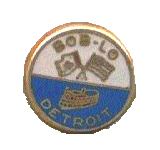
Company and special group picnics continued to draw well in the 1960s and the ferries did good business. For the opening of the 1965 season on May 29th, the boats began flying the new Canadian Maple Leaf Flag for the first time. New that year was CKLW radio's Golden Studio 80 where they broadcast live from the park every weekend & holiday, and for two additional days each week. They continued to sponsor Bob-Lo at least in to the mid 1970s.
A ride located in the park during this decade was a "Caterpillar". It was perhaps purchased as a used unit, or it may have been there for some time, but not mentioned. Steve Franks of Detroit says "As a ride I never missed, The "Caterpillar" was always in the park. Its canopy was very old, faded, worn, (and hole-filled) all through the 1960s. The ride was certainly not new in my earliest remembrances, which would go back to perhaps 1958 when I was 8 years old."
A 1972 park map still shows The "Caterpillar"; the 1991 map does not. If it was as old as appeared to Steve, it may have been a Traver or Herschell model.
Steve continues: "Some of the other rides I NEVER missed in my earliest visits were the park's mainstays: The train ride around the park pulled by diesel style engines, The `Whip' in an open-air pavilion across from the train station, `Tilt-A-Whirl', and `Tumble Bug' rides". As mentioned farther back, this "Whip" must have been a replacement unit because the closing auction list gives a date of 1950, yet one was in the park in the 1920s. The same goes for the "Tilt", which shows a 1974 date on the same list.
"Another of my favourites was a Traver-like `Circle Swing' ride likely called The `Rockets'. It had gondolas accommodating several riders and resembled Flash Gordon era rocket ships." Steve is correct. The "Rocket" cars were replacements for the "Circle Swing" ride's "Seaplane" cars, which had in turn been updates offered by Traver Engineering as replacements for their original Victorian-era gondola cars. Before The "Rockets", Boblo had used Traver "Seaplane De Luxe" cars and the ride was known as The "Aeroplanes". Later, Traver employee RE Chambers had taken over the plant and offered "Rocket" cars as updates to the "Seaplane" ones. (See Scarboro Beach Park for a full description of The "Circle Swing".)
|
Aeroplanes
1940s 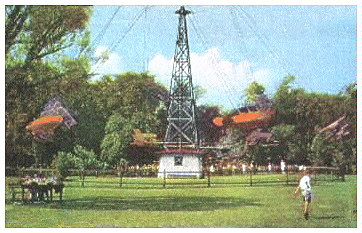
|
Recent evidence has come to light that Bob-Lo had a "Tunnel of Love" ride which used two-passenger swan boats. Martin Magid of Bloomfield Hills, Michigan has submitted that this ride was in the park from the 1960s until the park's closing, although with a brief interlude in the mid 1970s when the boats were removed. They would return by 1978.
After the park closed and a few weeks before the auction, the owner of a frozen custard/miniature golf establishment in Chesterfield Township, Michigan contacted the park's owner or auction company and was able to purchase two swan boats along with eight totem poles, plus the pencils and scorecards from the miniature golf course, which still had the Bob-Lo logo or name on them.
This owner said he remembered The "Tunnel of Love" when he went to the island as a youth, which calculates out as being in the 1960s. As well, his current customers have said they recognise the swans as being from that same ride.
However, it's become apparent that the ride changed over the years. Leo Boutette, of Vancouver, British Columbia, was a ride operator in the park in 1974. He does not remember the name "Tunnel of Love", so by then it was not an enclosed ride, but simply an open-water boat ride. It's possible that changing times saw the enclosure removed at some earlier point and the ride re-themed and re-named. Leo says that they ran in a lagoon near the edge of the river and were out of service the summer he worked in the park. A park map 1972 labels them simply as "Swan Boats", so the change occurred before that, possibly in 1969 during the start of this general upgrade to the park, as described farther on.
As the poor reputation of the 1930s and 40s was all but forgotten, and attendance of the 1950s, 60s, and early 70s rose dramatically, patronship eventually approached 1,000,000 in the mid 70s. All this did not come without cost, however, as the island now had its own water treatment waste disposal plants, along with a fire & rescue department to maintain.
A July, 1965 ad mentions the "Wild Mouse" and "Satellite Jet". It also claims there were 25 other amusement rides.
More than a dozen attractions were added from 1969 through 1974. These included a new restaurant, more shops, free shows, and in 1974, a new ferry was added to the Detroit Bob-Lo run: The City of Wyandotte. New rides would grow to include an Antique Car Ride, "Mammoth Slide" (a 16-metre high super slide that ran out for 50 metres), The "Swiss Toboggan" (with a 12-metre spiral drop and about a 55 km/h top speed - likely a Chance "Toboggan" compact roller coaster), The "Meteor", The "Mark V", "Saturn 6", a Flume Ride (Sansei/Arrow), Swan Boats (discussed above), a Tilt-A-Whirl" (Sellner, 1974), a "Rotor" (Chance, 1974), and The "Sky Streek" roller coaster. The "Rotor" was placed between the flume and coaster.
|
Antique Car Ride
1977 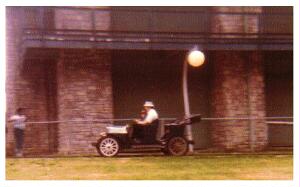
|
Michael Smith of Detroit drives an antique car. |
Note that The "Saturn 6" and "Satellite Jet" are similar rides, so this may have simply been a re-name, not a new installation. The "Swiss Toboggan" does not appear on the 1972 map, so its installation in the park must have been 1973 or 4.
|
This off-season view is taken from above
the marina (out of frame, bottom) and
looks across the island to the ferry
dock. In the foreground is the flume
ride. In the white area at Center Left
to Upper Left, lies The "Screamer" coaster.
|
Aerial View 1980s 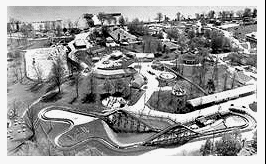
|
Information from Mike Schulte, has now surfaced on The "Sky Streek". It opened Sunday, May 27th, 1973 under the name "Thunderbolt" and replaced a white-painted wooden coaster of roughly the same layout. That wooden coaster was apparently also known as The "Thunderbolt". A co-worker of Mike's remembers that a wooden coaster was in the park in 1945 and 1946 but is unsure if he is confusing it with a coaster in another park. Another source says the Bob-Lo wooden coaster had an accident and was removed in the 1960s, but Mike and his co-worker feel a wooden coaster may have been there (operating or not) until 1972 when it was removed to make way for what would eventually be named The "Sky Streek". (Chuck Snider of Windsor disputes this, as is discussed farther on.)
The co-worker, however, differs in that he thinks the wooden coaster was on the southwest quadrant of the island, just north of the "Sky Streek" site. If this is true, it means both coasters may have been standing at the same time. He also remembers the name "Silver Streak".
|
Sky Streek
Date Unknown 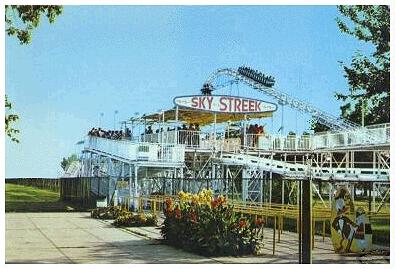
|
Steve Franks has this to say about The "Thunderbolt": "I visited the park every year from about 1957 to the late 60s and can tell you most definitely that the park did indeed have a large or medium sized wooden coaster, though I cannot attest to its actual name. It was situated near the end of the park's old midway (leading off from the train station). This placed it most likely where the later all-steel "Sky Streek" was to be installed in the 1973 season - that being the Northeast quadrant of the park. As one who had a fear of coasters as a child, I always saw `Thunderbolt', but never rode it."
"It was an all-wooden coaster with a traditional white-washed superstructure. My final visits to Bob-Lo in the very early 70s were more or less restricted to the boat ride and back, so I never saw its all-steel replacement "Sky Streek", but have seen pictures.
"I might say that the two coasters could hardly be confused, as the old coaster had a definite heavy-duty wooden supporting superstructure, while the "Sky Streek", even as steel coasters go, barely had any visible supporting structure at all - looking more like a `portable contraption with legs' than a fixed-pier coaster with typical steel pylons."
Recent research has come up with a story which may involve The wooden "Thunderbolt". It comes from Casey Duby and is about Deloris Duby. She was born in Windsor, Ontario in 1928 and at the age of nine, she was on a Bob-Lo ride when it broke down while at the tallest part of the track. After being stuck on the ride for about an hour, the ride operators brought a ladder to help each person down. Deloris was third to get off the ride. Two weeks or so later, she conquered her fear and went on again. The ride ran smoothly for its entire length. It's not clear if this was a roller coaster, but it sounds like one. Perhaps this was the "Thunderbolt". If so, the year would have been 1937 or 38, meaning a coaster was in the park then. Mike Schulte speculates that this may have been The "Tumble Bug". If this is the case, this latter ride is older than the 1940s, as was spoken of earlier.
|
Tumble Bug
1940s ? 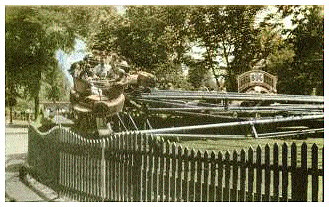
|
As mentioned, Chuck Snider of Windsor disputes that the wooden coaster was in the park until 1972. He says: "From 1968 through 1975 I was employed by Bob-lo Island, first as a ride operator, then ride supervisor and picnic director, and finally, Ship's Master on the Canadian ferries. I worked in all areas of the park and have many memories of its rides during that period. I used to hang around with the ride mechanics on my off time and occasionally worked with them repairing rides. I actually lived on the island during the summers of 1970 and 1971."
"I can assure you that there was no full size roller coaster anywhere in the park before 1972. On the site where the steel coaster was eventually built, was a very large wooden grandstand with a heavy open substructure which, I suppose, could be confused in memory for that of a coaster."
Taking everything into account, it may mean that a wooden coaster was in the park from the late 1930s through the mid 1960s, but was removed before Chuck came to work there in 1968. That would jibe with what one source said about a wooden coaster having an accident and being removed in the 1960s. (Research continues on the Boblo wooden roller coaster.)
The above speculations aside, the new steel coaster was supposed to have been placed near or on the same site as the woodie, painted white, and have a similar out & back layout. (This may be the reason that the coaster used the name "Thunderbolt" for a period of time, as the new steel coaster was supposed to have the *exact* layout as the old, according to one source.)
The $600,000 ride was manufactured by Sansei of Japan (some references incorrectly spell it "Sensei"), with 24-seat trains, each using four, 3-bench cars, a 21-metre lift hill, 762 metres of track, and a top speed of 88 km/h. This figure is either an exaggeration, or the lift hill height is incorrect. 88km/h requires a drop of about 31 metres, while a 21-metre drop gives a theoretical speed of 73 km/h, so one or the other is wrong. A 1973 newspaper report gives a top speed of 67 km/h, which fits better, so the 88 km/h is likely an exaggeration. Rides were 60 cents.
The "Thunderbolt" name was used for the new steel coaster for at least for the 1973 - 1976 seasons, as shown in an article by Jenny Nolan for The Detroit News. Further, an ad for the new ride appeared in the same paper on May 25th using that name. It is not yet known exactly when the ride name changed to "Sky Streek".
After the park's demise, this ride was bought by Selva Magica (Magic Forest or Jungle) in Guadalajara, Mexico. It ran there starting in 1994 under the name "El Cascabel", and now "Titan".
The two coasters have been confused over the years by many sources. Mike Schulte says this about the "Sky Streek" steel coaster: "In many ways its design resembled the classic wooden coaster. It was a simple out-and-back oval. Except for the lowest spots, it featured a catwalk alongside the track. The banked fan-turn was braced with radial, tension rods anchored at the center point of the curve. It had a covered brake run. The trains looked like they could have come out of the PTC factory. Except for the sparse support-structure, the coaster could very easily be mistaken for a wooden ride when viewed from a distance measured in either metres or years. And I don't think most of the general public would notice the support structure's density."
"I have noticed that The `Sky Streek/Streak' (the spelling was changed at some point) had a few subtle painting differences over the years. The bulk of the track and structure seems to have always been white. At some point in the last few years of the park, the tops of the highest hills were painted a light blue. In a 1973 film, one train was white, the other red. In a 1978 video, the train involved in an accident (see below) was yellow, and another in the background was red. In a 1983 video, a blue train is shown. By 1993, at least one train was painted in a red-white-blue, stars-and-stripes motif. Also, sometime between its opening and 1983, very noisy anti-rollbacks were installed on the far turnaround." He also seems to remember that there were fan-turn guy wires put in just after that modification.
Eric Vandommelen of Edgerton, Wisconsin says of this ride: "Of all of the roller coasters I've ridden (track record = 72), I've never seen a layout quite like The "Sky Streak". Most out-and-backs have the straight portions of their track (the "out" side and the "back" side) right next to each other, and make compound curves for the ends. (Think like a dumbbell shape.) The Sky Streak" had at least 9 - 12 metres between each side. The easiest way I can describe it is that if viewed from above, The "Streak" had the same shape as an auto-racing oval track."
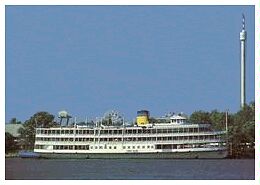 A Ferry sits at berth while The Sky Tower rises above the trees. |
Kelly McLaughlin of Toronto, Ontario grew up in the Boblo Park area and like many teenagers, she spent her summers working as a ride operator. In the 1980s, she worked in what was called "Zone 4", which included The "Log Flume", "Sky Streak", a "Rotor", The "Sky Tower", an "Enterprise", a "Tilt-a-Whirl", and a "Scrambler". |
Kelly says "I witnessed very few accidents, but I will never forget the day I was operating The "Sky Streak" and a wheel fell off on the first hill. We saw white `smoke' (paint coming off the tracks) coming behind the train and a horrible sound. The train made it to the `horseshoe', went part way round and started to roll backwards! It actually had enough momentum to travel back over the previous hill, only to rock back and forth, back and forth at the bottom. The riders cheered! - until we made them climb the ladders and the intricate latticework to come back to the station."
Leo Boutette remembers one morning it was forgotten to remove the wooden brake run covers before a train test. When the train reached the run, it jammed to a stop. Leo says: "It took all the park mechanics to pry the train back out so that they could remove the brake box parts and repair them."
|
Park Characters and The Enterprise 1980s 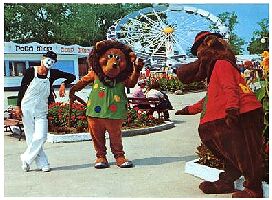
|
| Some of the park's characters pose for the camera. The lion is "Louie" and the bear is "Bobbie". Behind, is The Enterprise in action. Note at Upper Left background, a "Pogo" concession. |
Mike Schulte goes on to say that two other coasters were operating in the early 1970s: A kiddie coaster and the "Wild Mouse". The kiddie coaster might have been installed in 1973 or 74. A 1972 park map doesn't show it, but ride operator, Leo Boutette, remembers one in 1974. Then again, some park maps do not accurately show kiddie rides, so it may have been installed earlier. Regardless, a 1977 brochure does list it.
New information, courtesy of Chuck Snider, has surfaced. He says: "The kiddie coaster was a concession ride owned by the island's manager at the time, Ken Capstick. I do recall that the lighted marquee on the ride did read "Little Dipper". Although it was a portable ride I don't think it left the island at all. It was installed in 1970 or 1971 and Andy Dwyer was the area ride manager for the kiddie coaster in 1971."
This information, plus the photo below, indicate the ride was likely a Herschell "Little Dipper" and it was in the park from at least 1971. Being a concession, may be the reason it was not on the 1972 map.
Kelly Smith-Inman of Indianapolis, Indiana says: "I have many fond memories of Bob-Lo. The rides aboard the steamers Columbia and Ste. Claire were as much fun for me as the amusement park itself, and an important part of the experience. The Skyride was great fun and I loved being able to look out over the park. The zoo and aquatic shows were also favourites, since I have always loved animals. I also remember seeing a high-dive show at one point (it may have been during my last visit to the park in 1987)."
Regarding The "Little Dipper", she says: "The kiddie coaster at Bob-Lo was the very first one I ever rode. While I was initially afraid of fast rides as a young child, I eventually learned to love roller coasters. My grandmother, the late Ethel Smith, was a coaster enthusiast and I remember seeing her ride the Sky Streak with her hands up in the air. On my last visit to Bob-Lo in 1987, I rode the Sky Streak with a group of friends. We were thrilled when the operator didn't stop the coaster in time as we approached the platform, and we got to go around the track a second time."
|
Little Dipper
1977 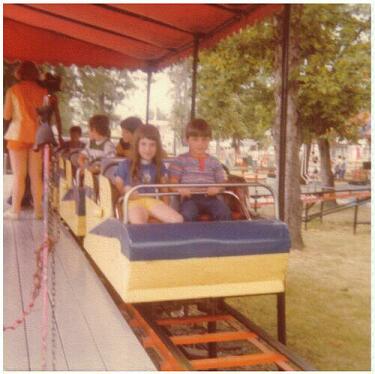
|
Kelly Smith and friend on the Little Dipper. Note part of the track layout in the right background. |
As for The "Wild Mouse", it was installed in 1957, and would have been the first such ride in Canada. (Another "Mouse" ride was imported for The Canadian National Exhibition in 1957, but apparently didn't operate until August.) Mike says the lift hill was to the left of the station, which spanned across the front of the ride. The lift ran up away from the midway so those watching The "Mouse" saw riders' backs as they ascended the lift. Part of the track layout ran over top of the station roof, which rattled with every car passing."
Leo Boutette describes: "The lift faced away from the midway. At the top, the track went into a dip and rode on a high serpentine section. That was followed by two dips, a run above the station, and a drop before a final rise. A number of turns at low level completed the run before the return to the station."
"The operator controlled two sets of brakes, one for the loading area at the left of the station and one for the unloading area at the right of the station. There were also the block brakes that were able to stop cars at various points along the track in case of an emergency."
"We had one or two new cars that year (1974) with the grill, headlights and hood ornament. The other cars had had extensive body work and the frills had been removed."
Although Mike felt this ride might have been steel-structured, Leo says this was a wooden "Mouse" model: "I know for sure it was wooden because just before the island opened for the season, a worker welding the steel flat track (on the wood) caught a beam on fire. He ran for a bucket of water, but the damage resulted in the beam being replaced before the ride could be opened."
It turns out they were both right. A picture (below) shows that the structure had vertical support columns and main cross beams made from wood, but joined together with steel cross bracing (tubing). As well, the track was steel `I' beam. The cars were a rectangular automobile style and used center "mushroom" guide wheels. I feel Leo is incorrect regarding his 1974 date either for the car updates or for the photos. If the photos are from 1974, the updates were done earlier. If the updates were done in 1974, then the photos are from a later year. However, evidence suggests that the updates were done three to five years earlier than 1974. Perhaps Leo's memory of the wooden support beams is confusing the issue. (See farther on.)
|
Wild Mouse
The first two shots are courtesy of Leo Boutette and were taken from the station, according to him, in 1974. The midway is behind the photographer. The last is from an unknown source and date, but is likely earlier in time. It shows a closeup of the Cat's Mouth. |
|

|
The lift hill is to the far left. It leads to a zig-zag track section in the structure above. Note the track passing "through" the cat's mouth and then undulating near ground level - first away from, and then towards, the viewer. It then turns into the structure at lower right to head to the unloading platform. |
|
In this view (right of the previous), two cars may
be seen. The yellow is about to turn towards the
viewer to come into the station. After loading, it
would then continue to the left, turn right, and
proceed up the lift, as seen at the far left of the
previous image. The up-turning track at the left of this photo has just risen out of the lower structure to start its run over the station roof (out of frame, top). Note the white park maintenance vehicle in the near background. |
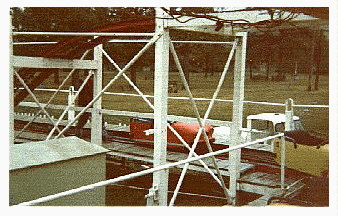
|

|
| This is likeley an earlier photo from the above. Note the diferent style cars and the track. The latter appears to be wood. Given this and the other two photos, it's likely that the "Mouse" rides were the same but that the original received track and car updates at some point. (See text below.) |
Despite the photos above, there is some evidence that there may have been two "Mouse" rides in the park. Victor Canfield came across an Eric Wedemeyer advertisement in a November 1957 issue of "Billboard" magazine. Wedemeyer was the U.S. representative for Klaus. The ad describes imported German rides being offered for sale:
Original "Wilde Maus"
Made in Germany.
Portable
Sturdy and Safe Construction
Laminated Wooden Track
Preconvention Showing, Bob-Lo Park, Detroit
Mike Schulte speculates: "This could have been just a transitory, operating display that was later moved to the referenced convention. In that case, Bob-Lo might be considered as having had two `Mouses'. On the other hand, this may be the same ride, but the laminated-wood track could have proved a maintenance headache and been replaced with the steel track - perhaps as an upgrade from the manufacturer." Victor speculates, however, that this ride may not have been the same one as was later at Bob-Lo.
However, evidence makes it now appear that this early model was modified over the years to become the one shown in the first two photos above. All-steel track apparently replaced the wood/steel 1957 track structure and new cars were added. This likely happened in the late 1960s or early 1970s. Given that a general upgrade of the park began in 1969 and that the steel "Mouse" shows up on a 1971 park map, it's likely the modifications occurred after 1969, and before 1971.
Steve Franks recalls the all-wooden "Wild Mouse". He says "I distinctly remember it in the 1960s, having ridden it as my ultimate thrill ride regularly. It had `in-line' seating for two, with mouse-like appearing cars. From my memory, it was a very traditional early wooden mouse from Germany and called "Wilde Maus". Its layout was not at all like the modern steel mouse layouts."
Steve has also uncovered a reference to Wedemeyer:
Portable German Wild Mouse Rides
Bob-Lo Island, Ontario
1957 or 1958
Eric Wedemeyer, Inc.
He continues: "Wedemeyer was best known in the mid to late 1950s as the importer of "Roto-Jets", "Strato-Jets", and "Satellite Jets", manufactured in Germany by the firm of Kaspar Klaus. Wedemeyer claimed at the end of 1956 to have sold three German "Wild Mouse" rides to Palisades, Pontchartrain, and Whitney's Playland. However, he also mentioned that the German manufacturer had limited production capacity, and stated that an arrangement had been made with the German maker to have Joseph McKee of Palisades duplicate the ride. Wedemeyer advertised "Wild Mouse" rides from 1956 until at least the end of 1957, and reported two additional sales in 1958. However, it is not clear what parks bought these rides, and installation has not yet been confirmed. By 1959, Wedemeyer's advertisements no longer mentioned `Wild Mouse' rides."
However, the Wedemeyer ads in the spring of 1957 are for:
The Original "Wild Mouse": A new Serpentine Roller
Coaster. Built for us Exclusively by Reliable German
Manufacturers. We also Undertake to Construct this
Ride on Inland Locations with Factory Engineers
Under Supervision of Mr. Joseph McKee, the Famous
Roller Coaster Authority.
By fall of 1957, the ads distinguish the Original "Wilde Maus", as confirmed above in Victor Canfield's "Billboard" reference:
Made in Germany
Portable
Sturdy and Safe Construction
Laminated Wooden Track.
Preconvention Showing, Bob-Lo Park, Detroit.
"This is the `Mouse' I remember", says Steve. He has a 1972 Bob-Lo map which does not show the wooden "Wilde Maus", but instead, the later steel "Wild Mouse" which was installed in the Southern section of the park, and east of the old Casino or Dance Pavilion. This "Mouse" also shows up on a 1971 park map.
A 1974 directory lists an athletic field, boat excursions, fun houses, a marina, miniature golf, picnic facilities, pony rides, puppet theater, roller rink, train ride (Chance/C.P. Huntington ?), and the zoo.
Steve Franks remembers trains that the Browning's originally bought for the park were replica diesels and represented as diesels as late as the 1972 map. "These were replaced with Chance/C.P. Huntington locomotives which I never saw, so they must have arrived sometime after 1972 - perhaps even as late as 1979, as noted in the auction roster at the park's closing."
1976 and 77 seems to be the most likely years they were changed. As well, a third train was added in 1978 or 1979. As Steve points out, these dates come from the closing inventory list, as seen at the end of this article.
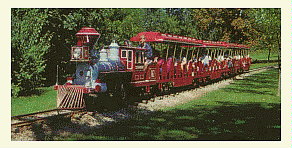
|
|
Miniature Train Ride
1980s or 90s
|

For 1974, Pay-One-Price admission was $5.85 for kids, $6.85 for adults. Leo Boutette remembers rides for that season: an Antique Car Ride, "Flying Scooters" (Bisch-Rocco), Carrousel, "Dodgem" (bumper cars), a Dark Ride with a Haunted House theme, Ferris Wheel, a Flume Ride, Kiddie Coaster, Miniature Train, Mini-Put Golf Course, "Round-Up" (Hrubetz), "Rotor" (Chance), "Scrambler" (Eli Bridge), "Sky Diver" (Chance), Sky Ride with ski lift-style cars, "Strato-Jet" a Huss hydraulic airplane ride), Super Slide", Swan Ride, "Tilt-a-Whirl", "Wild Mouse", and The "Zugspitz" (Chance "Swiss Bobs"... or might it have been the "Cortina Bob", as previously mentioned?).
He also recalls visiting a few years previous to his work term when the park had an "Octopus" (Eyerly, 8-car model) and a "Caterpillar".
Leo details some of the rides: "The `Caterpillar'. A two-person wide car rode an undulating circular track. Once the ride was running, a cloth cover would slowly rise from the right side of all the cars and cover them in a long circular cloth tube that looked like a caterpillar."
"The Hydraulic Airplane Ride (Herschell `Sky Fighter'. 1958). There may have been two seats to each car - one facing back and the other forward. The occupant could adjust the height of individual planes (maybe a rocket rather than a plane) by pushing a switch or operating a lever on the dashboard of the plane. He could also fire a noisy gun."
"The `Octopus' (Eyerly) had eight 2-person cars at the end of four split arms radiating from a center hub. The arms rose & fell as the hub rotated and the cars spun on a vertical axle at the end of the arms."
"The `Round-Up' (Hrubetz) - people line up on the inside edge of a horizontal fenced cylinder - about 30 riders. The cylinder is spun pinning people to the walls and then once it's at speed, the whole cylinder is raised - the edge closest to the operator least, the edge furthest, the most. It continues to rise until the cylinder spins in an almost-vertical position."
"The Sail Planes (Bisch-Rocco `Flying Scooters' - see photo below) utilised cable-suspended buckets hung from arms connected to a center spinning hub. In my memory, the supports seem to be a flat set of spokes at the top of the drive shaft. Each bucket had a rider-controlled sail that allowed it to climb and dive. The drive mechanism was inside a wooden structure which obscured the operator's view of a parent loading a child."
This ride was in the park under the name "Flying Dutchman" and appears in the closing inventory. Although it had a 1940 date, the ride may not have been put in until after 1948 when the Browning family took over the park. As well, the postcard pictured below refers to this ride under the name of The "Comet". It's likely that the name was changed during this ride's stay in the park.
|
Comet
1950s 
|
|
This is a Bisch-Rocco "Flying Scooter". Riders may dive, yaw, and pitch by manipulation of the front-mounted sail. |
Leo continues: "The `Sky Diver' was a single thickness vertical wheel with caged cars facing along the rim of the wheel. The front and back of the cars were mounted on pins so the cars rotated by user control around the rim as the entire wheel turned."
"When I was in High School (Amherst High), The `Sky Diver' was at the front of the island (boat side), where a new, compact steel coaster (`Galaxie') would be placed in 1976. The summer I worked there 1974), it was mid island." This ride may have been a Conklin Shows concession, but another researcher came up with the name Tom Goss. See farther on.
"The `Scrambler' was gasoline operated. I had to get gas to refill it on Friday and Saturday nights after the mechanics had left for the day at 6 PM."
"The Super Slide was made of corrugated steel. It was coated with spray starch at various times to reduce friction."
"The `Zugspitz' - (Chance `Swiss Bobs' ?) Two or three person-cars navigated a circular undulating track. The ride ran forward and then stopped and went backwards. It had blaring music."
1974 saw some changes and additions at the park. The "Haufbrau Haus", a German-themed restaurant opened. The "Sky Ride" was moved to the front (dockside of the island) to pass over the golf course and Antique Car ride. One of the "Sky Ride" stations became a craft area: candle makers, caricature art, wood carvers, and glass blowers. M&M/Mars and CKLW sponsored the park that year with a Two-For-One admission with any candy wrapper from M&M/Mars.
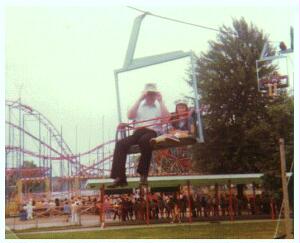
|
The Sky Ride 1976 |
|
Michael Smith and his daughter Kelly on the Sky Ride
shown here in its moved-to location. The coaster in
the background appears to be The Galaxie. |
As previously mentioned, in 1974, a new ferry was added to service the island. Red and Tom Browning bought a small, used tour boat and after refurbishing, began a run to the island from Wyandotte Michigan. The boat had many problems and an accident, as spoken of by Leo Boutette: "The boat was on its way to be refurbished had a problem with a gear change or something and ran into someone's boat house - thus needing more extensive repairs than anticipated originally. The ship was dubbed City of Wyandotte and even before its maiden voyage it had become known by its initials: "COW". Even customers somehow started calling it by that name."
Chuck Snider adds: "It had been in service for some time and had a history of breakdowns and temporary removal from service for repairs. In fact, I was the Master on Duty on one of the Papoose ferries when The Wyandotte went aground on the Amherstburg shore."
"It became my job to cross to the scene and transfer the passengers from it to my vessel, as the water surrounding The Wyandotte was too deep for them to get ashore. They were taken back to the island for transfer to The Columbia and a return to Wyandotte, Michigan. The irony of the collision was that the "boathouse", which was actually a waterfront gazebo, was made from a salvaged lake freighter wheelhouse."
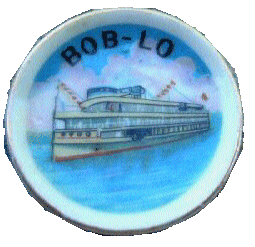
A delay of another kind happened on June 9th of that year. 65 km/h winds blew The "Ste. Clair" off course into the shallows of The Detroit River near Wyandotte. The boat grounded and a tug had to pull it into deeper waters, but not until almost 800 passengers had been stranded for three hours.
One other improvement occurred when in 1975, the antique carousel was restored and put back into operation. By 1976, or 1978, depending on the source, the park advertised 32 rides (35 rides in 1978) including a new funhouse ("Amaze-Amaze"), and new double swings. Improvements were being made because of the increased attendance, which topped 700,000 in 1976.
However, Bob-Lo's good fortune was not to last. As the number of rides and patrons increased, so did the likelihood of accidents. It was the accumulation of these incidents over the years that eventually gave the park an unsafe reputation and led to its demise.
The first accident had occurred in 1965 with one immediate death and eight others injured on The "Bug" (a Traver "Tumble Bug"), when a car disengaged from the rest of the ride at 8:15 PM on August 25th. Reports of the time say a broken leaf spring was at fault.
This ride has a circular, undulating track with a string of six round cars moved by sweeps tied to a central motorized mechanism. The operator said that the car broke free at a low point in the track shortly after he had pressed the "stop" button to slow down and stop the ride. "Detroit News" photos of the time show the gap in the string of cars and the failed car against a fence near the track. An investigation cited faulty construction materials. A $750,000 law suit was filed in 1966 for the injured riders, but there is no word on its outcome. A 1976 article in the same paper says that one of the injured eight remained in a coma and eventually died in 1968. The "Bug" was apparently repaired and returned to service because Mike Schulte clearly remembers a ride of that type being in the park during his 1974 visit.
In 1971 a ride operator for the kiddie coaster was seriously hurt when she attempted to cross the track. She slipped and was struck by the train. It damaged her leg badly enough that she required an extensive hospital stay. Chuck Snider relates: " A ride operator was seriously injured in 1971 when she crossed the track to turn the ride off at the end of a run. Due to a really poor design, the train had to be turned off by tripping the power switch which had been placed on one of the uprights across the track from the loading platform and entrance."
"The operator, whose name was Ann(?) Hooper I believe, misjudged her timing, slipped on the rail and had her leg run over by the train. Her calf was almost severed from the leg. As, at that time, I was one of those primarily responsible for operating the island's ambulance service, I was called to the scene and, with one of the mechanics, Bob Pouget, who was also trained in first aid, treated her while she was transported by barge to Amherstburg for transfer to an AA&M Ambulance and then to hospital in Windsor. Doctors there managed to save her leg, but it required, I was told, over 400 stitches. She recovered well over the summer and was walking with only a slight limp when I last saw her."
On June 3rd, 1973, a girl suffered injuries when she was thrown from The "Wild Mouse", as did two others who were thrown from The "Sky Streak" and knocked out. In 1974 just before opening day, an employee was struck by a coaster as she attempted to cross the track, resulting in a summer-long hospital stay.
On June 11th of that year, a mother and daughter were injured on The "Scrambler" when one of the cars came loose from its mounting. These cars are held to the end of each sweep by three mounts which are connected to the cars using 25 millimetre diameter pins. These pins stick through from the mount into the car. A cotter pin then secures the main pin. The cotter pin dropped out of one of the mounts and the resulting ride motion worked the car loose. It leaned forward enough that the foot trough lowered and hit a counter-rotating cross beam which runs out from the center hub. The daughter was ejected from the car and the mother suffered significant cuts to her legs as the trough was crushed and pushed backward.
Leo Boutette volunteers: "Because it was a stationary ride (not portable like a carnival) the pins were old and rusted, except for the clips (cotter pins). After this incident, to make the ride more secure (and so an operator would be willing to come back and work it) the retaining clips that secured the pins in place were each wired shut so they couldn't drop or be pulled out without first removing the closing wire."
The new-for-1976 $300,000 "Galaxie" also had several accidents. It was a concession ride apparently operated by Tom Goss, whom had previously run the ride in Maryland. There is some discrepancy on this point as Mr. Goss was supposedly from Salisbury Beach, Maryland, but no such place shows up on a Maryland map, yet there is one in Massachusetts. So the ride may have come from there instead.
Late in July, the "Galaxie" was involved in an injury to a maintenance man. He was injured when a ride operator was not paying attention and she did not stop a car at the exit platform. The maintenance man tried to grab on to stop the car by hand. While watching the maintenance man attempt that, the operator failed to stop yet another loaded car. The maintenance man got pinned between the cars when they collided and suffered damages to his legs. The injury didn't keep him from work as he was interviewed not longer afterward.
Around a week later on June 4th, two female employees from Windsor suffered injuries while being trained to operate this same ride. They suffered back injuries due to improperly set brakes while doing on-ride testing. Their car stopped short and they were ejected. The brakes were adjusted and the ride opened the next day. A short time later, a girl was thrown from this ride at the same spot.
In 1978, two girls were hurt when they fell from a cable car, and ten passengers were injured on The "Sky Streak" roller coaster on July 13 due to a sudden braking and partial roll-back, bringing the total to 32 injured or dead in only 13 years.
This all resulted in significant attendance drops for 1978 and succeeding years, although the ferry Midnight cruises continued on Friday & Saturday through the mid & late 1970s. In 1975, there were two special trips by The "Columbia" recreating the cruises of old from Detroit to Port Huron/Sarnia via Lake St. Clair.
However, these did not help the park, and despite the addition of more rides (a total of 35 by 1978), a refurbished kiddieland, the return of The "Swan Boats", the Safari Zoo and dolphin shows, and reduced prices via free days and discount tickets, after the 1978 season, Bob-Lo was advertised for sale by the Browning family which had owned the park since the late 1940s.
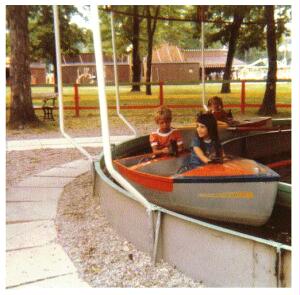
|
Boat Ride 1977 Kelly Smith pilots a boat. |
|
Dolphin Show 1977 |
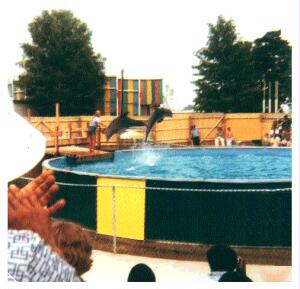
|
This was the real start of the end for Bob-Lo. A consortium bought the park in 1979 for $5,000,000, which turned out to be anything but a bargain. Because of falling attendance and medical settlements, the park had considerable unpaid taxes, as well as owing some suppliers. The new owners (Cambridge Properties, operating under The "Island of Boblo Company") spent another $5,000,000 in improvements in an effort to replace the crowds lost by the park in the 1970s.
In the 1980 "Boblo Island Pictorial Guide Book" are mentioned or shown: The Front Gate buildings, bumper cars; a ferris wheel, a "Scrambler" (Eli Bridge), "Enterprise" (Huss), "Monster" (Eyerly), & a "Pirat" (Huss). Also mentioned is The "Carrousel Theatre" which was converted from the old roller skating rink. Up to 1,250 watched four musical review shows daily, one of which was in 1950s costumes with a large "ELVIS" backdrop. The brochure also shows the log flume, The "Sky Streak", The "Galaxie", the antique car ride, the train, and the "Maxivision" stand-up theater. The island had 17 picnic areas, 10 of them with shelters. They had hosted company picnics with as many as 5000 people.
Another ride listed for the early 1980s is "Flight to Mars". Paul Worona of Center Line, Michigan says: "My family used to frequent Boblo Island when my sisters and I were children. It was one of our favourite rides. It was actually a little, `Wild Mouse' type of dark ride. It had several small two or three-person cars that rode on a two-rail track inside a building similar to the cheesy semi-trailer mounted haunted houses you might see at a county fair. The exception was that there were a couple of chain lifts and short hills that added quite a few thrills to the ride. While you went on your journey, the cars would slam into closed doors, go around tight 90-degree turns and through 180 degree curves. Things would jump out at you, glow in the dark, and appear to be falling on you."
Kelly Smith-Inman reminisces: "Another favourite of mine was the cheesy-but-fun dark ride, that I remember as a haunted house, but from the photo, appears to have been the Flight to Mars ride. In this particular instance, I rode in a car with my father's co-worker and her son, and my father rode in the car behind us, since the cars only accommodated two large, or three small people. My dad's co-worker snapped the picture of him as his car emerged from the ride. I loved the roller-coaster-like dip in the track, and I remember one scene in which a barrel marked `TNT' teetered precariously on a ledge above the track and appeared ready to drop on you as your car passed beneath it."
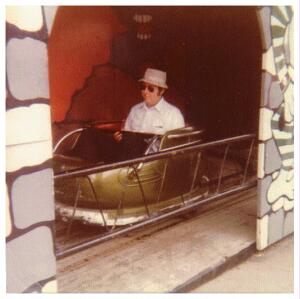 Michael Smith emerges from the dark ride. |
Flight to Mars
1977 |
|
Pirat
1980s |
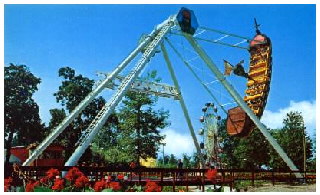 |
However, all these improvements were for naught - only 3 people boarded the boat on opening day 1980. By 1981, the new company would file for bankruptcy protection.
Still, at least some people continued to come to Boblo. Jim Abbate remembers a 1981 experience: "On September 26, we were at the park late at night when a tremendous lightning and rainstorm hit as we rode The `Sky Streek'. The operators could not brake the train and it flew through the station and up the lift, so around we went again. The fierce storm kept pelting us and the coaster flew through the station again. After four or five trips around, someone eventually thought to shut off the chain lift. This time the coaster flew through the station and about 60% of the way up the lift, it finally stopped."
"We had to get out and climb down the structure in the pouring rain. It was quite an experience. Even scarier was the thought of what could have happened if the train didn't make that turn in the station at such high speeds each time."
In 1983 a new owner, The American Automobile Association of Michigan, spent $15,000,000 over the next few years expanding the concessions, changing the park layout and adding rides such as The "Screamer" (1985), a Vekoma corkscrew roller coaster with a 23-metre lift hill and 732 metres of track. It had two corkscrew inversions, and attained a top speed of 65 km/h which equates to a 17-metre drop. If the trains actually dropped the full height, the top speed would be 76 km/h, so these figures may not be entirely correct.
|
Screamer
late 1980s |
 (See the "Happy Face" photo, farther on, for another "Screamer" view) |
Larry Elie of Ypsilanti, Michigan remembers this ride being called "Twister" at some point in its history. He says the radio ads of the time used a version of one of Chubby Checker's "Twist" songs but as "Let's Twist Again This Summer". That implies the ride had the "Twister" name for at least two seasons. After Boblo's closure, this coaster ended up at Playland in Vancouver. La Ronde in Montreal runs one of these models, as well.
Other things there in 1983 according to a film record were The "Galaxie", the big ferris wheel (still there at park's end) with rotatable tubs, Rocco "Flying Scooters", the log flume, high-dive & song-and-dance shows, and a "Scrambler".
The park must have sold their other "Scrambler" and replaced it with a newer one. According to Star Telegram and Amusement Today articles, this "Scrambler" opened in 1961 with Six Flags Over Texas in Arlington, Texas. It was sold in 1983 to Boblo Island Park and presumably stayed there until the park closed. It is now back at the Texas park, installed on the former site of The "Air Racer" as The "Missile Chaser", which was the name used originally. Considering that 7 years passed between the closing of Boblo and Six Flags' 2000 installation,
I wonder if it is the same ride or not. If not, where was it for those 7 years? An additional wrinkle is that the Boblo closing auction has the ride listed with a 1965 date, instead of 1961.
New information has surfaced. Gary Slade of the publication `Amusement Today' says ".... I can tell you that The "Scrambler" that opened at Six Flags Over Texas in 2000 is the one from Boblo Island. It was part of a ride package Six Flags bought during the park's auction. The Boblo Island log flume boats are also in operation at SFOT, on flume #1."
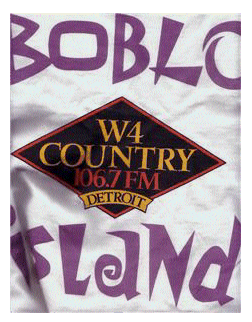 In 1984 the AAA owners also employed new Mississippi
riverboat-style ferries to run from Gibraltar, Michigan to Boblo
and installed a used (1970) Constram 96-metre tall observation
tower (The "Sky Tower"). AAA then advertised heavily. It paid off.
Attendance approached 3/4 of a million and the park was sold in
1988 for $21,000,000 to International Broadcasting, which at the
time owned The Ice Capades and Globetrotters basketball team.
In 1984 the AAA owners also employed new Mississippi
riverboat-style ferries to run from Gibraltar, Michigan to Boblo
and installed a used (1970) Constram 96-metre tall observation
tower (The "Sky Tower"). AAA then advertised heavily. It paid off.
Attendance approached 3/4 of a million and the park was sold in
1988 for $21,000,000 to International Broadcasting, which at the
time owned The Ice Capades and Globetrotters basketball team.
A 1986 guidebook shows The "Galaxie" and "Screamer", but The "Wild Mouse" and Kiddie Coaster were gone. They may have been removed when The AAA took over, or possibly earlier. Also removed by 1987 was The "Galaxie". A 1978 park brochure also shows that the park had acquired some more corporate sponsors. They included the Canadian Automobile Association (CAA), Kodak and Pepsi Cola. By 1991, Colombo Yogurt and Winter Sausage would also be sponsors, and by 1993 (the park's final year), Domino's Pizza, Greyhound, Hostess, Kraft, Royal Bank, Sealtest, Segram, Sprint, Sunshine, Tim Horton's, and others had joined.
In 1988, another Vekoma steel coaster called "Nightmare" was added to bring the total to three or four at Boblo. I do not have date for when The "Toboggan" was removed from the park. If it was still there in 1988, the coaster total would have been four. However, the most recent evidence says that was not the case.
Eric Vandommelen relates: "I went to Boblo at the end of the summer of 1987, around an August or early September time frame. At that point, The "Galaxie" was totally gone - not SBNO (Standing, but not Operating), but fully removed. I remember the following season's ads for the opening of "Nightmare", but never got back to the park." A 1991 map shows that the concrete pad upon which The "Galaxie" had stood was being used as an open-air roller skating rink.
Thus, according to Eric, by 1988, there were only three coasters at the park: "Sky Streak", "Screamer" and "Nightmare". "Nightmare" was a Vekoma enclosed steel ride with a compact layout of 350 metres of track and an 8.5-metre lift hill. It ran a single 12 X 2-passenger train. Total area was about 25 X 30 metres square. This ride is now The "Mayan Mindbender" at Astroworld in Texas.
A March 14, 1989 "Detroit News" article reports that Boblo has an annual estimated $1 million advertising budget.
A ride shown in a 1991 Guide Book is The "Flying Swings". This appears to be a Zierer "Wave Swinger". It was in the park's closing inventory, but it's unknown when the ride was installed.
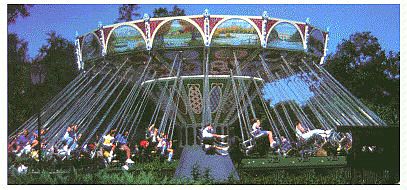
|
|
Flying Swings
1990s |
Other attractions near the end of the park's run were moonlight cruises, The "Boblo Maze" with a 15 X 15-metre layout, The Maxivision Theater, and the "Sky Tower" for a panoramic view of the island and Detroit River. Also available were roller skating and bicycle paths. Along with this were shows that featured Acrobats of China, stunt skiers in a water show, magicians, and live bands & dancers. By this time also, the park boasted 7 souvenir outlets, 2 restaurants and 15 snack bars.
By the early 1990s, the popularity of The "Simpsons" television show was high enough that the park decided to acquire a franchise. Homer, Marge et al, roamed the park entertaining the patrons. Three other park characters were a happy face and two bears, whose names are not currently known. It's unclear if these characters were retired after the Simpson's entered the picture or not.
|
Happy Face and Bear Characters 1990s 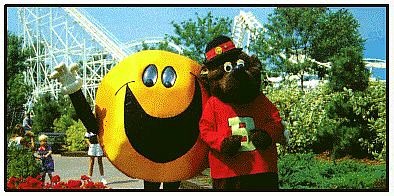
|
| The bear character is "Bobbie". Note The Screamer coaster in the background. |
But just as the park was turning around, they began to have problems with Detroit gangs. In one May 1988 incident, after numerous fights had broken out in the park, Ontario Provincial Police (OPP) were brought in to supervise the loading of the ferries back to The United States. The officers wore bullet-proof vests and had weapons.
The fights did not stop there. A confrontation broke out on the "Columbia" with some fighters brandishing knives. Frightened spectators rushed to other parts of the ship, and due to a rumour that the ship was sinking, some passengers put on life vests. When the ferry docked, everyone began to rush the gangway. Security tried to control the flow of people hurrying to disembark, but could not hold back the crowd as there were only 15 to 20 security personnel on board. Some passengers jumped over the railing onto the dock in their zeal to leave the confines of the ferry.
As patron numbers dropped during the next few seasons, ferry services were decreased or eliminated with "Ste. Claire's" last voyage on Labour Day of 1991. Admission was raised from $15.95 to $17.50 for adults coming via ferry from The U.S. The park began to be closed on Tuesdays that year starting in mid June. Rides began to be sold in order to keep the park afloat, including in February 1990 the precious antique Mangels-Illions carousel which netted over $1,000,000 from individual-piece sales.
A 1992 park brochure advertises "Captain Andy's Rivertown Review" (a puppet/music show), "Back to Bones" (a nature show about mammals and reptiles), "World's Greatest Illusions Magic Show", an Olympic High Diving Team, Children's Petting Zoo, Kid's Kingdom, and Boblo Blading. The latter likely refereed to roller blading.
Still, the reduction of ride numbers only reduced attendance further. By the fall of 1992 after repeatedly trying for a sale and supposedly experiencing its worst attendance ever, the park sought bankruptcy protection. (1990 attendance was 610,000, 1991 saw 400,000, or 520,000 as reported by another source, and only 280,000 came in 1992.) The owners were unable to improve things and so the park was sold at auction on February 10th, 1993 for 3.7 million to Northern Capitol Corporation.
They planned to run the park two more summers then turn it over for development; but two days before the end of the 1993 season, one of the owners, Michael Moodenbaugh, was critically injured in a car accident when his Bronco II rolled over four times from a highway entrance ramp to land on its roof. He was unbelted and got thrown 10 metres whereby he suffered a broken back, injured lungs, and by one report, also a fractured neck and skull. Passenger Shawn Frame was wearing a seat belt and received no series injuries.
When the park closed on September 30th, it would never reopen. It meant the loss of 860 jobs. Moodenbaugh's backers, especially investor Larry Benaroya, had less interest in an amusement park and gained control of it through a court order. They began to sell off the rides and anything else of value. The island and contents were eventually auctioned for $3.7 million, recouping the initial investment. All that remained were The "Sky Tower", roller rink and the dance pavilion. Ironically, during this final season, Boblo set a one-day attendance record of 17,812 for a music festival and fireworks.
Michael Schulte says about The "Sky Tower": "It was sold to Elitch Gardens with the intent to install it at their new downtown Denver site. Plans changed and they installed a new tower instead. It was decided to keep the tower at Boblo. As of June 2003, I saw it standing on the island. I doubt it has gone anywhere since then. It is quite easy to see from several points along the U.S. side of the river."
By August 1994 the mainly empty land was sold for $4.2 million to developer John Oram, who is building luxury homes, a golf course, shops and restaurants on Boblo's former site. See the site: Boblo Island Today. In October 1995, Oram began selling residential lots for $90 - $270 thousand (U.S.)
The "Columbia" and "Ste. Claire" were auctioned in 1996. The "Ste. Claire" date is in contention because it was listed as a historic landmark in The State os Michigan in 1992, which seems to preclude any sale of it. In June of 1999 Oram announced that he wished to recreate the amusement park on the mainland near Amherstburg, Ontario. It is slated to include a luxury hotel, international shops & restaurants, a 107-berth boat dock, and a pier large enough to accommodate lake cruise ships along with The S.S.
The ferry will be a permanent dance hall with shops and a museum. This new amusement area is slated to be called The Boblo Boardwalk.
Here is a website dedicated to the preservation of both these ships:
-Boblo Boat "Ste. Claire"
Since Boblo's coasters and their years of operation
are confusing, here is a summary of what has been
discovered so far:
|
1895 - 1930s
|
No information has yet surfaced on coasters for this
time period. Yet, I can't believe they did not have a
"Figure 8" or other popular coaster sometime during
those decades.
|
|---|---|
|
1930s or before - 1967 ? |
Thunderbolt
Those of you who remembered a wooden
coaster at Boblo were correct. In 1973, a steel coaster
was built with a similar layout to the previous wooden
coaster that may have been in the park possibly from
the 1930s onward. Boblo may have wanted a lower-maintenance
steel version of its out & back woodie. Both coasters were
white in colour. Their similar layouts and colours seem to
be the basis of some of the confusion. Added confusion comes from the fact that sources show "Sky Streek" was called "Thunderbolt" for at least the 1973 through 1976 seasons. It's possible where the park wanted an exact replacement, that they initially used the same name. The spelling was changed to "Streak" sometime in its life and one person remembers it being called "Silver Streak". It may also be possible that both coasters ran for that one season, thus the confusion as to names. While it appears this is wrong, at least two people believe these coasters did not occupy the same location, and thus could have run together. |
|
1957 - Late 1960s?
|
Wilde Maus
This was an all-wooden "Mouse" model,
most likely a Klaus or possibly a Mack
model. It was apparently modified to
a steel "Mouse" in the late 1960s or
early 1970s.
|
|
Late 1960s - Late 1970s or Early 80s |
Wild Mouse
This was a steel "Mouse", but apparently
larger than the similar Schiff models of the time. It shows
up on a 1971 park map. Manufacturer is unknown at this point.
It now appears to have been the Klaus model above, but
modified with new, all-steel track and updated cars. No date as to its removal, but likely not many seasons after 1973, as a girl was thrown from the ride that season. Mike Schulte and Leo Boutette say it was still there during the 1974 season, though. |
|
1970 or 71 - 1983?
|
Kiddie Coaster
Likely a Herschell "Little Dipper". Apparently a concession
ride. No removal date, but likely gone by the early 1980s,
perhaps being removed as late as 1983 when The AAA took over
and revamped the park. It does not appear in a 1986 guide
book.
|
|
1973 or 74 - Late 1970s or Early 80s |
Swiss Toboggan
(Chance "Toboggan" coaster). No
removal date, but likely late 1970s or early 1980s;
possibly as late as 1983 when The AAA took over.
|
|
1973 - 1993
|
Thunderbolt/Sky Streek/Sky Streak
(Sansei. Steel out & back).
As commented on above. Now running in Selva Magica Park,
Guadalajara, Mexico under the name "El Cascabel".
|
|
1976 - 1986
|
Galaxie
(SDC). A concession ride, but considering its
length of stay in the park, Boblo may have bought it at
some point.
|
|
1983 - 1993
|
Screamer
(Vekoma "Corkscrew" model ). Now at Playland
in Vancouver as "Corkscrew".
|
|
1988 - 1993
|
Nightmare
(Vekoma enclosed, compact steel). Now at
Astroworld, Texas as "Mayan Mindbender".
|
First is a rides list from the final season at Boblo. The dollar figures shown are the asking prices by the liquidation company, Performance Rides. Following that is a shows list for Boblo Island Park from the early 1990s and then a list of other attractions.
Dates represent the manufacture's and are not necessarily the year a given ride was installed in the park. The price chart is courtesy of Mike Schulte as was published in "Inside Track" magazine. Full information was not available for some rides, or was not able to be reconciled with the auction list, thus there may be some duplications. Realise, it should not be inferred that being on this list means a given ride was actually operating at the time of the park's final closure.
(Some Netscape Users May Have to Scroll Down)
| Description | Model | Year | Price |
|---|---|---|---|
| Antique Cars (Arrow) | Park | 1988 | $15,000 |
| Auto Scooter (Soli 21-Car) | Park | 1970 | $8,000 |
| Boats (Herschell, Kiddie) "Boblo Boat" Water Ride | Portable | 1940 | $7,000 |
| Carousel (Chance. 11-metre) Antique Unit Replacement | Park | 1990 | $165,000 |
| Carousel (Reverchon, Kiddie) | Portable | 1971 | $18,000 |
| "Dangler" | ? | ? | ? |
| "Dodg'em" (Mack Deuce 17-Car) | Park | 1950 | $5,000 |
| "Enterprise" (Huss) | Park | 1980 | $175,000 |
| "Falling Star" | ? | ? | ? |
| Ferris Wheel (Vekoma 21-metre) | Park | 1964 | $65,000 |
| "Flying Swings" (Zierer ?) | ? | ? | ? |
| "Flying Dutchman" (Bisch-Rocco) (Was The "Comet") | Park | 1940 | $5,000 |
| "Flying Saucer" (King's) | Portable | 1950 | $2,000 |
| Flume Ride (Sansei) 18 Arrow Boats | Park | 1971 | $5,000 |
| "Mini Scooter" (Sartori) 14-Car | Park | 1974 | $4,000 |
| "Nightmare" Roller Coaster (Vekoma) | Park | 1988 | $350,000 |
| "Octopus" (Eyerly) | ? | ? | ? |
| "Pirat Ship" (Huss) | Park | 1980 | $165,000 |
| "Rotor" (Chance) | Portable | 1974 | $20,000 |
| "Roundup" (Hrubetz) | Portable | 1967 | $15,000 |
| "Satellite Jets" (Klaus) | Park | 1960 (1957) | $5,000 |
| "Scrambler" (Eli) | Portable | 1961 ? 65? | $20,000 |
| "Screamer" Roller Coaster (Vekoma) | Portable | 1985 | $850,000 |
| "Sky Fighter" (Herschell) | Portable | 1958 | $5,000 |
| "Sky Streak" Roller Coaster (Sansei) | Park | 1973 | $150,000 |
| "Sky Tower" (Constram Observation Tower) | Park | 1970 | $200,000 |
| "Tilt-A-Whirl" (Sellner) | Portable | 1974 | $25,000 |
| Train (Chance/CP Huntington) | Park | 1976, 77, 79 | $60,000 |
| "Umbrella" (Hampton) | Portable | 1970 | $10,000 |
| "Venture River" | Park | 1984 | $3,000 |
| "Venturer" (Sellner) Turnpike & Cars | Park | 1974 | $3,000 |
| "Whip" (Mangels, Kiddie) | Portable | 1950 | $4,000 |
|
|
|
|
|
|
|
For more looks at Boblo Island Park, see:
My thanks to writer Chris Carlone for much of the initial information
on the park. |
Return to the
Closed Canadian Parks Index